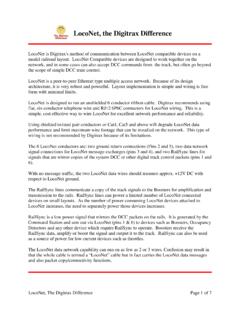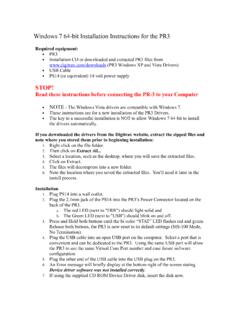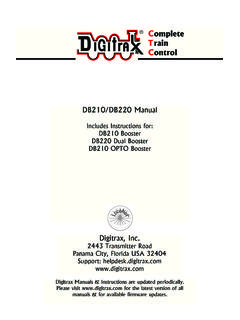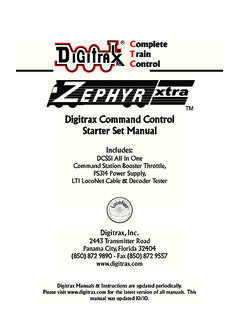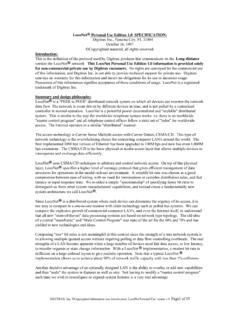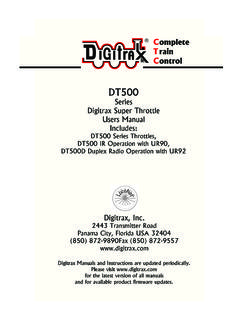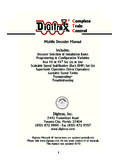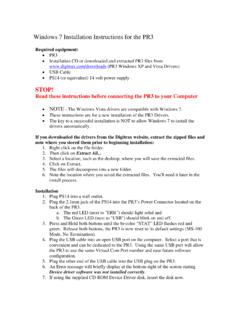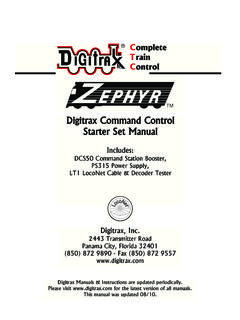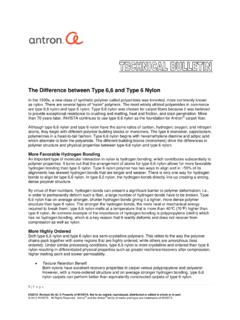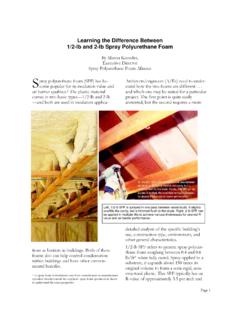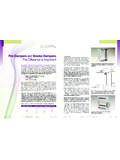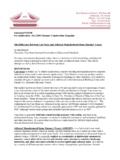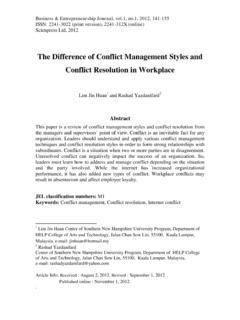Transcription of LocoNet, the Digitrax Difference
1 LocoNet, the Digitrax Difference LocoNet is Digitrax 's method of communication between LocoNet compatible devices on a model railroad layout. LocoNet Compatible devices are designed to work together on the network, and in some cases can also accept DCC commands from the track, but often go beyond the scope of simple DCC train control. LocoNet is a peer-to-peer Ethernet type multiple access network. Because of its design architecture, it is very robust and powerful. Layout implementation is simple and wiring is free form with minimal limits. LocoNet is designed to run an unshielded 6 conductor ribbon cable. Digitrax recommends using flat, six-conductor telephone wire and RJ12 6P6C connectors for LocoNet wiring. This is a simple, cost effective way to wire LocoNet for excellent network performance and reliability. Using shielded twisted pair conductors or Cat4, Cat5 and above will degrade LocoNet data performance and limit maximum wire footage that can be installed on the network.
2 This type of wiring is not recommended by Digitrax because of its limitations. The 6 LocoNet conductors are: two ground return connections (Pins 2 and 5), two data network signal connections for LocoNet message exchanges (pins 3 and 4), and two RailSync lines for signals that are mirror copies of the system DCC or other digital track control packets (pins 1 and 6). With no message traffic, the two LocoNet data wires should measure approx. +12V DC with respect to LocoNet ground. The RailSync lines communicate a copy of the track signals to the Boosters for amplification and transmission to the rails. RailSync lines can power a limited number of LocoNet connected devices on small layouts. As the number of power consuming LocoNet devices attached to LocoNet increases, the need to separately power those devices increases. RailSync is a low power signal that mirrors the DCC packets on the rails.
3 It is generated by the Command Station and sent out via LocoNet (pins 1 & 6) to devices such as Boosters, Occupancy Detectors and any other device which require RailSync to operate. Boosters receive the RailSync data, amplify or boost the signal and output it to the track. RailSync can also be used as a source of power for low current devices such as throttles. The LocoNet data network capability can run on as few as 2 or 3 wires. Confusion may result in that the whole cable is termed a LocoNet cable but in fact carries the LocoNet data messages and also packet copy/connectivity functions. LocoNet, The Digitrax Difference Page 1 of 7. Digitrax uses the following LocoNet Wiring Convention: This arrangement is called a data cable in the telephone industry. LocoNet Wiring: The Theory Behind the Practice Digitrax recommends using the 6-wire configuration for the following reasons: 1.
4 In a 6 wire flat configuration, the left 3 wires are effectively a "mirror" image of the right 3 wires. 2. There are 2 Ground (pins 2 & 5) and 2 LocoNet data connections (pins 3 & 4), so the effective "loop resistance" is lower because of paralleled wires. This lets LocoNet run over greater distances. 3. If one ground or signal connection is broken or intermittent, the network can maintain a reliable connection. 4. The two outside wires (pins 1 & 6) carry opposite phase copies of the master system rail packets, this is called RailSync. RailSync allows LocoNet boosters and other LocoNet devices to be connected anywhere along a cable run. This works even with cable runs of thousands of feet and in the presence of noise and interference. 5. The balanced nature of the cable and the way the signal currents propagate in this "RF. Quad" configuration generate the lowest possible RFI radiation and EMC susceptibility or inward interference pickup.
5 This is a good thing. This is part of the reason Digitrax LocoNet handily passes the FCC Class B radiation Certification requirements. 6. LocoNet's philosophy and architecture allow "free-form" wiring with no termination or "linear-bus" restrictions. You can star, tee, branch, or expand LocoNet in any configuration. LocoNet can be used in any configuration except for a ring. You should NEVER connect LocoNet back on itself, because pins 1 and 6 should not be connected. LocoNet, The Digitrax Difference Page 2 of 7. LocoNet Wiring: The Specifics 1. LocoNet supports a total cable length of up to about 2000 feet depending on actual wire type used and its capacitance. 2. No two devices should be connected by more than 1000 feet of cable. 3. LocoNet can be split & branched in any free form style. 4. The only network current pull up termination needed is provided by the Command Station.
6 There should be only one Command Station the layout. 5. Do not loop LocoNet back on itself. Looping LocoNet back on itself causes RailSync (pins 1 and 6) to be shorted together and to be out of phase. This causes it to look like an overload to the driver circuit. 6. LocoNet works best when the network cables are 22 AWG to 28 AWG. The recommended 6 wire flat telephone type ribbon cable is 26 AWG. 7. Plug and play design using 6 wire telephone type cables and RJ12 jacks makes setting up LocoNet quick and easy. 8. Plug in your LocoNet Cables in the same pin orientation around the layout for best results. LocoNet Wiring: LocoNet Cables LocoNet Cables must be reliable and well made, or you may see intermittent connectivity and spotty operation on the layout. If areas of the layout exhibit intermittent issues, bad cables may be the problem. Bad cables on your layout can be very frustrating and are completely avoidable by simply testing each cable before you install it on the layout.
7 It's easy to make LocoNet Cables. If you would rather purchase them, ready-made 6-pin male RJ12 to RJ12 cables of various lengths are available from sources such as DigiKey and Mouser. Be sure to use 6-conductor and not the similar 4-conductor plugs and wires. If you purchase pre- made cables, make sure you test them as described below before using them. Tools You Will Need: 1. Quality RJ12 Crimping Tool 2. Quality 6 Conductor Flat Telephone Type Cable 3. RJ12 Connectors 4. Diagonal Cutters Step by step instructions for making LocoNet cables: 1. Use quality tools and materials! Digitrax recommends against using plastic crimping tools, they can flex instead of crimping the wire to the connector. 2. Measure the length of the cable needed and cut the flat telephone cable with the diagonal cutters. 3. Using the crimping tool, strip the outside jacket from the telephone cable to expose the 6.
8 Individual wires inside the jacket. 4. Verify the order of the wires matches the diagram above (White, Black, Red, Green, Yellow and Blue). LocoNet, The Digitrax Difference Page 3 of 7. 5. Hold the cable with the freshly stripped end pointing away from you. Orient the cable so the White wire is on the left side of the cable. 6. Insert an RJ12 Connector on the cable. When inserting the connector, make sure the metal contacts are facing up and the tab is on the bottom. 7. Visually inspect the wires through the plastic to make sure the wires are still in the proper order. 8. Make sure the connector is inserted fully on the wire. 9. Place the cable and the connector into the crimp' portion of the crimper. 10. Compress the handles of the crimper to crimp the connector onto the cable. 11. A properly crimped cable has all the wires fully inserted into the connector, the strain relief contacting the outer jacket of the cable and the metal contacts making a connection with the individual wires.
9 12. Perform the same steps on the other end of the cable. Test EVERY LocoNet Cable before installation as follows: 1. Commercial cable testers can be used to test LocoNet Cables. Follow the instructions provided with the cable tester to test cables without connecting them to LocoNet. Once the test is completed good, cables can be installed on the layout. 2. Every Digitrax Starter Set includes an LT1 for testing LocoNet cables. LT1 LocoNet Testers can also be purchased separately. 3. Plug one end of the LocoNet cable being tested into the LT1. 4. Plug the other end of the LocoNet cable being tested into LocoNet 5. Turn on Track Power using a throttle. 6. Make sure address 00, the analog loco address, is set to 0 speed. 7. Leave the throttle plugged in to LocoNet. 8. If the cable is good ALL 4 LEDs will glow. a. LED 1 checks RailSync White & Black wires b.
10 LED 2 checks LocoNet Black & Red wires c. LED 3 checks LocoNet Green & Yellow wires d. LED 4 checks RailSync Yellow & Blue wires 9. If any of the LEDs fail to glow or are dim, cut the ends off the cable and crimp new connectors on the cable. Re-test the cable. If it still fails the test, there may be a problem with the cable itself and you should consider discarding it. 10. DO NOT leave the LT1 connected to a running layout, because it adds an extra unnecessary load LocoNet. It is meant to be used as a simple temporary diagnostic tool. LocoNet, The Digitrax Difference Page 4 of 7. LocoNet Jacks LocoNet Cables are plugged into LocoNet Jacks located around the layout. LocoNet Jacks are available on all LocoNet compatible components. Shorted Contacts Inside LocoNet Jacks Can Cause LocoNet Problems: 1. If the contacts inside the LocoNet jacks are accidentally shorted, LocoNet may exhibit strange behavior or may stop working all together.
